- Arabic
- French
- Russian
- Spanish
- Portuguese
- Turkish
- Armenian
- English
- Albanian
- Amharic
- Azerbaijani
- Basque
- Belarusian
- Bengali
- Bosnian
- Bulgarian
- Catalan
- Cebuano
- Corsican
- Croatian
- Czech
- Danish
- Dutch
- Afrikaans
- Esperanto
- Estonian
- Finnish
- Frisian
- Galician
- Georgian
- German
- Greek
- Gujarati
- Haitian Creole
- hausa
- hawaiian
- Hebrew
- Hindi
- Miao
- Hungarian
- Icelandic
- igbo
- Indonesian
- irish
- Italian
- Japanese
- Javanese
- Kannada
- kazakh
- Khmer
- Rwandese
- Korean
- Kurdish
- Kyrgyz
- Lao
- Latin
- Latvian
- Lithuanian
- Luxembourgish
- Macedonian
- Malgashi
- Malay
- Malayalam
- Maltese
- Maori
- Marathi
- Mongolian
- Myanmar
- Nepali
- Norwegian
- Norwegian
- Occitan
- Pashto
- Persian
- Polish
- Punjabi
- Romanian
- Samoan
- Scottish Gaelic
- Serbian
- Sesotho
- Shona
- Sindhi
- Sinhala
- Slovak
- Slovenian
- Somali
- Sundanese
- Swahili
- Swedish
- Tagalog
- Tajik
- Tamil
- Tatar
- Telugu
- Thai
- Turkmen
- Ukrainian
- Urdu
- Uighur
- Uzbek
- Vietnamese
- Welsh
- Bantu
- Yiddish
- Yoruba
- Zulu
Oktoba . 10, 2024 14:26 Back to list
timing belt video
Understanding Timing Belts A Key Component of Engine Performance
Engine efficiency and performance are critical to the success of any vehicle, and one of the most vital components that contribute to this functionality is the timing belt. This relatively small yet crucial piece plays an essential role in harmonizing the engine operations. Today, we will explore the significance of timing belts, their construction, maintenance, and the implications of failure, while also providing insights on how to replace them efficiently.
What is a Timing Belt?
A timing belt is a highly durable rubber belt with teeth or grooves that synchronize the rotation of the crankshaft and camshaft in an internal combustion engine. By coordinating the timing of these two essential engine components, the timing belt ensures that the engine’s valves open and close at the proper intervals in relation to the position of the pistons. This synchronization is vital to ensure that the engine runs smoothly and efficiently.
Construction of Timing Belts
Timing belts are constructed from a variety of materials, primarily synthetic rubber, and reinforced with fiberglass or steel for added strength. This composition allows them to withstand the high levels of tension and heat generated within the engine compartment. The teeth along the belt ensure a firm grip on the gears, minimizing slippage and maintaining the precision needed for effective timing.
Maintenance and Inspection
Like any other component of a vehicle, timing belts require regular maintenance. Most manufacturers recommend inspecting the timing belt at regular intervals, typically every 60,000 to 100,000 miles, or as specified in the owner's manual. Signs that a timing belt may need replacement include visible wear, cracks, or fraying, and in some cases, a ticking noise indicating a possible misalignment.
Maintaining attention to the timing belt not only helps extend its lifespan but also provides the opportunity to address other related components such as the water pump and tensioners, which are often replaced simultaneously. This proactive approach can save vehicle owners from significant repair costs down the line.
Implications of Timing Belt Failure
timing belt video

Failure of a timing belt can lead to catastrophic engine damage. In interference engines, where the space between the pistons and valves is minimal, a broken timing belt can cause pistons to collide with open valves, leading to bent valves, damaged pistons, or in some cases, complete engine failure. This sort of damage can cost thousands of dollars to repair, highlighting the importance of regular inspections and timely replacements.
Replacing a Timing Belt
Replacing a timing belt is a job best suited for trained mechanics, especially considering the complexities involved in the procedure. However, understanding the process can empower vehicle owners with knowledge about their car's maintenance.
1. Preparation Before beginning, ensure you have all necessary tools and replacement parts, including the timing belt, tensioner, and any supplemental tools needed for the specific vehicle model.
2. Disassembly Disconnect the battery, remove components obstructing access to the timing belt, and carefully take off the old belt. During this phase, it is essential to mark the alignment of the crankshaft and camshaft to maintain proper timing.
3. Inspection Replace any worn or damaged components, including tensioners and pulleys, to ensure the longevity of the new belt.
4. Installation Install the new timing belt following the manufacturer’s specifications, ensuring that all components are aligned correctly.
5. Testing After reassembling the engine, reconnect the battery and start the engine to ensure it runs smoothly. Listen for any unusual noises that could indicate misalignment or issues needing immediate attention.
Conclusion
In conclusion, the timing belt is a critical component that significantly influences vehicle performance and longevity. Regular maintenance, timely replacements, and a thorough understanding of its functions and construction can save vehicle owners from unnecessary repairs and ensure that their engines run efficiently. Whether you opt to handle the replacement as a DIY project or leave it to professionals, understanding the timing belt's role is crucial in caring for your vehicle. Remember, a small investment in maintenance can lead to substantial savings and peace of mind in the long run.
-
Korean Auto Parts Timing Belt 24312-37500 For Hyundai/Kia
NewsMar.07,2025
-
7PK2300 90916-T2024 RIBBED BELT POLY V BELT PK BELT
NewsMar.07,2025
-
Chinese Auto Belt Factory 310-2M-22 For BMW/Mercedes-Benz
NewsMar.07,2025
-
Chinese Auto Belt Factory 310-2M-22 For BMW/Mercedes-Benz
NewsMar.07,2025
-
90916-02660 PK Belt 6PK1680 For Toyota
NewsMar.07,2025
-
drive belt serpentine belt
NewsMar.07,2025

